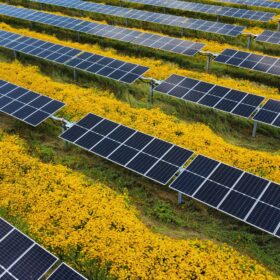As the planet grapples with the escalating impacts of climate change, the urgency for innovative, global solutions has never been more critical. With 75% of the Earth’s surface covered by water, recent studies have shown that these vast aquatic expanses are warming at a significantly faster rate than terrestrial environments.
This increase in ocean temperatures is driving a cascade of environmental catastrophes, including the melting of polar ice caps, widespread coral bleaching, global glacial melting, widespread coral bleaching, and significant alterations in ocean currents. While to date less widely publicized, this third impact is crucial because these currents distribute heat around the globe through vast, conveyor-like systems in the sea, which are now being disrupted by changes in ocean density and increased by warming, leading to potentially irreversible shifts in their patterns.
One of the most significant impacts of ocean warming is the potential slowdown of the global thermohaline circulation, often referred to as the “global conveyor belt.” This system circulates ocean water worldwide, influencing climate patterns globally. Warmer water is less dense and thus has a lower capacity to sink, which can slow down this circulation. Models suggest that continued warming could lead to a weakening, or even a shutdown, of key components of this system, such as the North Atlantic Deep Water formation, which could dramatically cool the North Atlantic and Europe. Additionally, warming oceans have been linked to more intense and frequent El Niño events, which impact weather patterns globally, including increased rainfall in some regions and droughts in others.
As illustrated by the noticeable weakening taking place in the flow of the Gulf Stream, the changes in ocean currents induced by warming are not just a future prediction; they are happening now, and their effects are being felt worldwide. These changes necessitate innovative approaches not only to mitigate the sources of warming but also to adapt to and manage the consequences already in motion.
These alarming trends underscore the immediate, desperate need for effective strategies to cool down the oceans and mitigate their wide-ranging impacts on the global climate system. While necessary, traditional environmental protection and carbon reduction methods are no longer sufficient alone to halt or reverse global warming trends. As a result, the scientific community is turning toward more radical geoengineering technologies designed to intervene directly in the Earth’s climatic systems on a grand scale.
One such innovative approach is marine cloud brightening (“MCB”), which has recently gained attention as a potential method to reflect sunlight away from the Earth’s surface and reduce the heat absorbed by the oceans. MCB builds on natural phenomena where sea salt acts as cloud condensation nuclei, enhancing cloud formation and reflectivity. The approach, first proposed by British atmospheric physicist John Latham in the 1990s, suggests that spraying seawater into the atmosphere to create fine droplets could increase the albedo of marine stratocumulus clouds. This would reflect more sunlight into space, thereby cooling the Earth. Early technological advancements by Stephen Salter and extensive computer modeling throughout the 2000s have explored the feasibility and climatic impacts of such interventions.
The albedo effect, where lighter surfaces reflect solar energy as opposed to dark surfaces, which absorb it, becomes even more important as more reflective ice melts due to global warming. Massive regions at the two poles and diminishing glaciers that once reflected a significant amount of sunlight begin to absorb more heat, thereby exacerbating warming in a feedback loop known as “ice-albedo feedback.” By enhancing cloud albedo over the oceans, MCB seeks to leverage this effect to reduce solar heat absorbed by the Earth, providing a compensatory cooling effect to counterbalance the loss of ice. However, despite promising models, MCB research continues to wrestle with the complexity of predicting long-term climatic outcomes and the potential ethical questions that could arise from such geoengineering techniques.
Current research, including field trials by private groups and academic institutions, focuses on gathering empirical data to understand these processes better and refine this climate intervention strategy. While MCB holds promise, operational challenges remain, particularly in terms of scalability and environmental sustainability.
To address these challenges, the World Business Academy has proposed a novel solution: the deployment of autonomous, solar-powered catamarans equipped with aerosol dispersion technology to efficiently distribute sea salt particles across the oceans can address these challenges. These vessels are designed to maximize the capture of solar energy through expansive solar arrays integrated into their dual-hulled structure. This design provides increased stability and surface area and allows for greater energy generation capacity, which powers the propulsion, navigation, and aerosol dispersion mechanisms, ensuring continuous operation without the use of fossil fuels.
The Energy Observer, a 100-foot catamaran launched in 2017 with the support of global entities like Air Liquide and Toyota (who contributed to the development of the hydrogen fuel cell technology used onboard), provides a valuable blueprint for the development of such autonomous solar-powered catamarans. The integration of solar arrays, hydrogen fuel cells, and advanced navigation systems demonstrated by the Energy Observer offers practical insights into building efficient, sustainable catamarans capable of long-term, autonomous, carbon-free operations proposed for enhancing MCB efforts to effectively combat global warming.
Preliminary estimates indicate that these solar-powered catamarans can significantly increase the area covered by MCB interventions, potentially amplifying their cooling effect on the planet—particularly if guided by advanced navigation systems that calculate the most effective dispersion routes based on real-time climatic data and oceanographic conditions.
The autonomous operation allows for continuous, long-term deployment, minimizing human labor and operational costs. Energy efficiency calculations suggest that the solar arrays can generate sufficient power for both propulsion and aerosol dispersion, even in varying weather conditions. The vessels would ideally be directed toward areas with the highest sunlight exposure to maximize energy generation and optimize the effectiveness of the intervention.
Introducing autonomous solar-powered catamarans for MCB deployment addresses several challenges associated with geoengineering efforts to combat climate change. By leveraging renewable energy, this approach reduces the carbon footprint of climate intervention techniques and enhances their sustainability. Additionally, the scalability of this solution presents an opportunity for global implementation, offering a path toward a significant impact on the Earth’s climate system.
Such autonomous solar-powered catamarans provide an additional benefit to climate science since equipping each catamaran with advanced sensors and tracking technology can play a vital role in monitoring changes in ocean currents. By collecting data on water temperature, salinity, and currents across different ocean regions, these catamarans can enhance our understanding of how global warming affects oceanic systems. With this knowledge and the ability to program the routes each craft autonomously sails, the deployment of MCB techniques by these catamarans can cool specific regions, offering a method to directly mitigate the impacts of warming oceans on current patterns.
The use of these catamarans represents a symbiotic approach. While they aid in cooling the oceans and reducing the heat absorbed at the surface, they also gather crucial data that can inform climate models and future geoengineering initiatives. This dual functionality – and its ability to be targeted at specific regions such as along the equator, where natural ocean currents can distribute the cooling effect – underscores the potential of integrating this technological innovation with environmental conservation and decarbonization strategies to address the complex challenges posed by global warming.
Further research and development are necessary to optimize the design and operation of these vessels, with pilot projects being a crucial next step for testing and validation. These projects will help refine the technology and assess its effectiveness and environmental impact in real-world conditions, providing a critical basis for broader implementation.
The World Business Academy
The World Business Academy was founded in 1986 as a result of discussions centered on the role and responsibility of business in relation to critical environmental and social challenges. Since that time, the Academy has been a 501(c)(3) non-profit that engages the business community in better understanding and practicing the role of business as an agent for positive social transformation and solutions to humanity’s largest challenges.
The Academy’s focus on climate change, energy security, hydrogen, and optimized corporate governance through advocacy of shareholder capitalism, results from an analysis of the most important threats to human survival. Its 38-year track record of leadership includes the publication of cutting-edge books, articles, podcasts, and videos discussing these topics and many other issues of primary importance to the evolving role of business in society.
Rinaldo S. Brutoco, founding president and CEO of the World Business Academy , a nonprofit think tank and action incubator that explores the role of business in relation to critical moral, environmental, and social issues of our time. He is an economics and business expert specializing in energy policy, renewable energy, finance, innovation, and the causes of, and adaptation strategies for, climate change. For his entire career, he has been an international leader in advancing the nature of good corporate governance, corporate accountability, business transparency, and ways that corporations can fulfill their social compact by providing goods and services that the public needs in financially prudent ways that are simultaneously consistent with sustainable environmental and employee compensation policies. He received a Congressional Commendation to this effect in October 2010 for his outstanding contributions to the field of corporate responsibility.
, a nonprofit think tank and action incubator that explores the role of business in relation to critical moral, environmental, and social issues of our time. He is an economics and business expert specializing in energy policy, renewable energy, finance, innovation, and the causes of, and adaptation strategies for, climate change. For his entire career, he has been an international leader in advancing the nature of good corporate governance, corporate accountability, business transparency, and ways that corporations can fulfill their social compact by providing goods and services that the public needs in financially prudent ways that are simultaneously consistent with sustainable environmental and employee compensation policies. He received a Congressional Commendation to this effect in October 2010 for his outstanding contributions to the field of corporate responsibility.
The views and opinions expressed in this article are the author’s own, and do not necessarily reflect those held by pv magazine.
This content is protected by copyright and may not be reused. If you want to cooperate with us and would like to reuse some of our content, please contact: editors@pv-magazine.com.








By submitting this form you agree to pv magazine using your data for the purposes of publishing your comment.
Your personal data will only be disclosed or otherwise transmitted to third parties for the purposes of spam filtering or if this is necessary for technical maintenance of the website. Any other transfer to third parties will not take place unless this is justified on the basis of applicable data protection regulations or if pv magazine is legally obliged to do so.
You may revoke this consent at any time with effect for the future, in which case your personal data will be deleted immediately. Otherwise, your data will be deleted if pv magazine has processed your request or the purpose of data storage is fulfilled.
Further information on data privacy can be found in our Data Protection Policy.